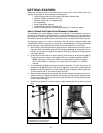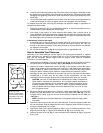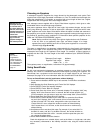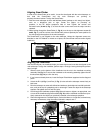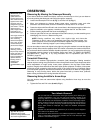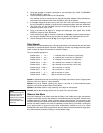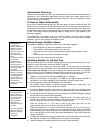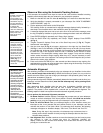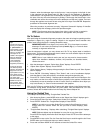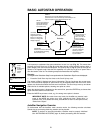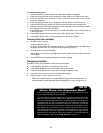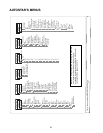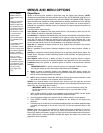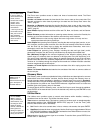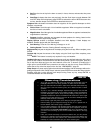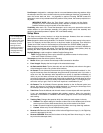
20
Ho
wever, when the telescope slews to the first star, it may not appear in the field of view
in the eyepiece. Use the SmartFinder (
17, Fig. 1) and /or the viewfinder (1, Fig. 20) to
locate the star. The alignment star will be easy to recognize—it will be the brightest star in
the area of the sky where the telescope is pointing. Look through the SmartFinder or the
vie
wfinder and use the Arrow keys to move the telescope until the star is visible. Then look
through the eyepiece and center the star using the Arrow keys. Press ENTER. Repeat the
procedure f
or the second alignment star.
When the procedure is perf
ormed correctly, "Alignment Successful" displays. If AutoStar
does not display this message, perform this procedure again.
NOTE: The alignment stars may change from night to night. All that is required is
f
or the observer to center the selected stars in the eyepiece when prompted.
Go To Saturn
After performing the Automatic Alignment procedure, the motor drive begins operating and the
telescope is aligned for a night of viewing. Objects in the eyepiece should maintain their
position even though the Earth is rotating beneath the stars.
IMPORTANT NOTE: Once aligned, only use the GO TO or Arrow keys to move the
telescope. Do not loosen the telescope locks (6 and 9, Fig. 1), or move the base
manually, or alignment will be lost.
Once the telescope is aligned, you may choose and “Go To” any object listed in AutoStar’s
Object menu. This exercise demonstrates how to select one such celestial object, the planet
Saturn, for viewing from the Object menu.
NOTE: Saturn is not visible the entire year and you may need to choose another
object from AutoStar's database; however, the procedure, as described below,
remains the same.
1 After the telescope is aligned, “Select Item: Object” displays. Press ENTER.
2. “Object: Solar System” displays. Press ENTER.
3. “Solar System: Mercury” displays. Keep pressing the Scroll Down key until “Solar System:
Saturn” displays.
4. Press ENTER. “Calculating” displays. Then “Saturn” and a set of coordinates displays.
Note that Saturn’s (and other planets’) coordinates change throughout the year.
5. Press GO TO. “Saturn: Slewing...” displays and the telescope slews until it finds Saturn.You
may need to use the Arrow keys to center Saturn precisely in the eyepiece. AutoStar then
automatically moves the telescope so that it "tracks" Saturn (or whatever other object you
may have chosen); i.e., Saturn remains centered in the eyepiece.
After you Go To Saturn, practice the Go To feature with other objects in the Object menu lists.
For example, during Winter, choose M42, the Orion nebula, from the Messier list. Or in the
summer, choose the Dumbbell nebula from the Deep Sky, Named Objects list.
Using the Guided Tour
This example demonstrates using “Tonight’s Best” Guided Tour.
1.
After obser
ving Satur
n, press MODE twice so that “Select Item: Object” displays again.
2. Press the Scroll Down key twice. “Select Item: Guided Tour” displays.
3. Press ENTER. “Guided Tour: Tonight’s Best” displays. Press ENTER.
NOTE: If you wish to try out other Guided Tours, press the Scroll Down key to scroll
through other tour choices. When the tour you wish to select displays, press
ENTER.
4. “Tonight’s Best: Searching...” displays. After calculating, “Tonight’s Best: Jupiter” displays.
NOTE: Different objects may be displayed on a tour list on any given night.
Press ENTER to displa
y inf
ormation about the object. Press GO TO to move the telescope
to the object.
5.
Press MODE to retur
n to the
Tour list. Press the Scroll keys to scroll through the list. Press
ENTER when you find the next object you wish to observe.
6.
Press and hold do
wn MODE f
or tw
o seconds to lea
ve the Guided Tour menu.
Tip:
The GO TO key also
allows you to perform
a "spiral search." A
spiral search is useful
when the telescope
slews to an object, but
that object is not
visible in the eyepiece
after the telescope
finishes its search.
(This sometimes
occurs during an
alignment procedure.)
Press GO TO when
the telescope stops
slewing.The telescope
begins to move in a
spiral pattern at a very
slow speed around
the search area.When
the object does
become visible
, press
MODE to stop the
spiral search. Then
use the Arro
w k
e
ys to
center the object.



